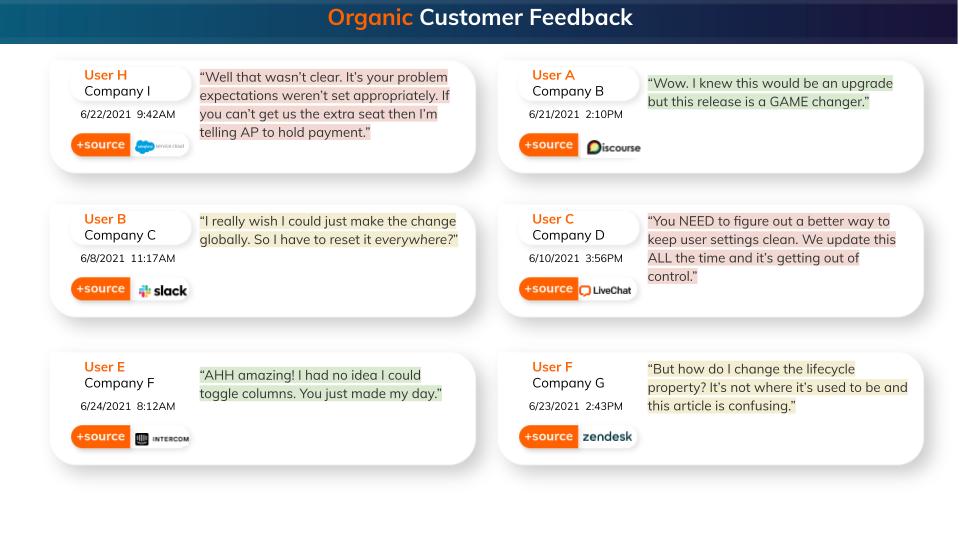Customer feedback is the lifeblood of CX. Without it, CX teams can’t measure the quality of their experience and have no compass to help them improve it. Many teams start by listening to feedback in two ways:
- Solicited feedback represents the responses you get from surveys — Customer Satisfaction (“CSAT”), Net Promoter Score (“NPS”), Customer Effort Score (“CES”), and so on.
- Behavioral feedback represents what you learn by watching customer behavior — engagement activity, transactions completed, etc.
In this post, we will focus on a third type of feedback that’s becoming both easier to harness and increasingly critical — organic feedback.
Organic feedback is the customer feedback you already have. It’s what customers volunteer in their own words in the channels you’ve made available to them, based on issues they were self-motivated to express.
While you have many separate channels and teams interacting with each customer, customers experience just one relationship with your company. Every interaction is a chance to share feedback — customers share many important needs and concerns outside of surveys and engagement checkpoints.
Many companies are already swimming in organic feedback that they aren’t measuring — support cases, web chat sessions, emails, community forum commentary, call center conversations, product reviews, and social media posts. These channels are bursting at the seams with things like feature requests, frustration with company policies, and reactions to creative workarounds from your Support team.
“I wish I could…”, “How do I…?”, “Is there an easier way to…?”, “It wasn’t clear to me…”

Why Is Organic Customer Feedback Important?
All types of feedback are important, but organic customer feedback plays an especially foundational role in measuring and improving CX. Organic customer feedback is incredibly powerful for a few reasons.
- It’s much higher in volume than solicited feedback and available in real-time — and it’s already available at your fingertips.
- Natural language is the common currency across customer interactions, no matter the team or the channel — customer verbatims in context are always high in-demand for every team, and with good reason.
- It’s agile. Instead of relying on solicited feedback based on questions you knew to ask, you can mine organic feedback for insights you didn’t even know to ask about.
- Organic feedback reflects real user statements and context, capturing the why underlying feedback better than a multiple choice answer.
- Because organic feedback comes from customer-facing operations, it’s easy to turn insights into actions that respond in-channel to improve the experience.
Organic customer feedback offers the context, consistency, and underlying data volume that CX leaders need to accurately measure customer experience and drive better, more customer-centric decision-making. It allows you to harness valuable exhaust from the vast volumes of the eye-opening customer interactions your business has with customers every single day.
If you’re relying only on behavioral and solicited feedback, you’re only seeing a sliver of your customer experience.
A Holistic Approach to Understanding Customer Experience
Think back to grade school for a moment. Your report cards were likely some combination of weighted graded assignments, class participation, and behaviors such as attendance. What if, instead, your school administrators simply asked your teachers to rate you on a scale of 1-10? How would you know what you need to improve to be a better student?
Or what if teachers gave you an A+ based only on your perfect attendance record, with no regard for late homework and answering the wrong essay question because you only studied for 1 out of 3? (me? never!)
The point is that students are, or at least should be, assessed across a variety of weighted criteria. Your customer experience should be, too. Simply showing up to class, or in a CX context, using the product, doesn’t mean that issues aren’t brewing.
So why are so many organizations betting their customer relationships on a small part of the picture? Organic customer feedback is the most abundant and important resource at your disposal to understand and improve CX.
CX teams need strong metrics that are grounded in verbatims from organic customer feedback. It’s the most reliable and high-volume underlying data source to measure customer sentiment, customer effort, outcomes, and the themes that drive each.
How To Collect Organic Feedback
Because organic customer feedback is unstructured, it’s historically been hard to capture and analyze. You could task your team with reading through customer interactions across all of your channels — but that’s like shoveling in the middle of a blizzard. By the time you wade through it all and synthesize the right set of themes to focus on, the window to take action may have closed, and a new set of themes will have emerged.
All that’s changing. Advances in Natural Language Understanding (“NLU”) technology mean that feedback intelligence tools can consolidate organic customer feedback from multiple channels and turn it into nuanced metrics that capture sentiment, effort, and themes across all of your customer interactions.
According to NTT’s Global Customer Experience Benchmarking Report, 77% of enterprises believe customer operations, including Voice of Customer, will be positively affected by AI. Winning CX teams are leveraging NLU-enabled feedback intelligence tools to ground CX measurement and action in organic customer feedback.
Organic customer feedback is the key to measuring and improving your customer experience with data-driven decisions that make an impact in the immediate and long term.


